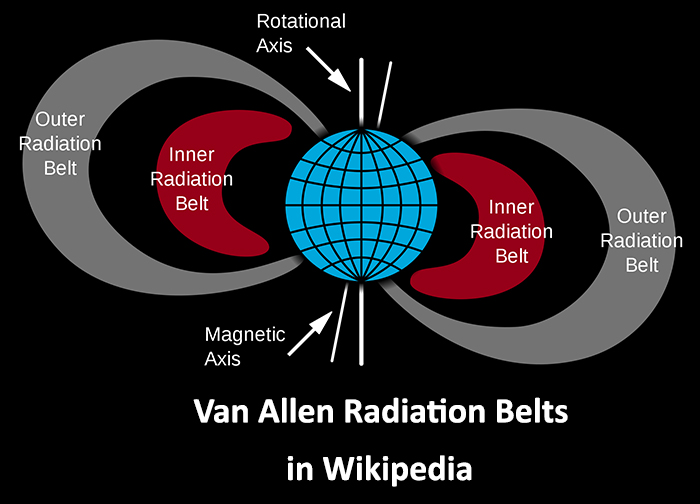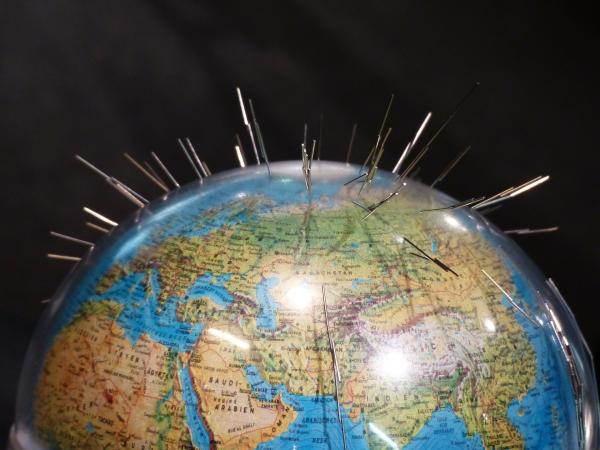In the last two pieces, we talked about how radiation affects the body and might affect astronauts. Now it is time to consider the Earth’s magnetic field, its effect on radiation, and how an anticipated magnetic field “reversal” might affect cosmic radiation here on Earth. Or, not to put too fine a point on it – do we have to worry that we’re all going to die? (Spoiler alert – no.) But before we can get to the biology, we really ought to start with a little bit of Earth science.
Why Earth has a magnetic field
When the Earth first coalesced about 4.6 or so billion years ago, it was a relatively homogenous piece of rock. Well…more likely a mixture of rock and magma because the final stages of formation probably involved some fairly massive impacts that would have liquified at least part, if not all, of the Earth. But the key feature is that when the Earth formed, it did not have the layers we see today – no crust, no mantle, and (most importantly) no core. During this period, it’s entirely possible that the Earth had a magnetic field of sorts, due only to whatever residual magnetism was frozen into the rocks as the Earth solidified. That changed, rather abruptly actually, about a half-billion after the Earth formed – a little more than 4 billion years ago.

 Early Earth was far hotter than today, partly from energy imparted by impacting asteroids and partly due to being at least ten times as radioactive as it is today. This extra heat permeated the planet and melted and coalesced the iron and nickel that diffused through the rocks. The liquid metal, being denser than rock, sank to the planet’s center, transforming the metal’s gravitational energy into more heat, which, in turn, made it easier for the remaining iron and nickel to sink through the softened rock, releasing still more gravitational energy. We believe this process ended with the majority of Earth’s iron and nickel sinking to the center, forming a core of molten metal with a molten silicate rock floating on top of it – what later became the Earth’s mantle and crust.
Early Earth was far hotter than today, partly from energy imparted by impacting asteroids and partly due to being at least ten times as radioactive as it is today. This extra heat permeated the planet and melted and coalesced the iron and nickel that diffused through the rocks. The liquid metal, being denser than rock, sank to the planet’s center, transforming the metal’s gravitational energy into more heat, which, in turn, made it easier for the remaining iron and nickel to sink through the softened rock, releasing still more gravitational energy. We believe this process ended with the majority of Earth’s iron and nickel sinking to the center, forming a core of molten metal with a molten silicate rock floating on top of it – what later became the Earth’s mantle and crust.
This left Earth with a core of molten metal, but possibly not with much of a magnetic field. Creating a magnetic field requires motion of some sort. This relative motion came from the molten metal's differing density (caused by temperature variations) that caused “convection cells” to sink and rise in relationship to one another. While over time, these convection cells have become more like rotating cylinders aligned with the Earth’s axis, it is still that relative motion that produces Earth’s magnetic field. According to studies of ancient rocks, it seems likely that the magnetic force formed at least 3.4 billion years ago and possibly even earlier.
Geologists studying the Earth’s magnetic field quickly realized that it has changed polarity – the direction in which the north and south magnetic poles point – repeatedly over the ages – and that the interval between these polarity reversals seems to have no apparent pattern. In the century or so since these reversals were recognized, scientists have several geodynamic theories explaining and modeling spontaneously magnetic field reversals; there is still no explanation universally accepted by the scientific community. While frustrating for scientists, luckily, it doesn’t matter much for our purposes – all we need to know is that these reversals happen. When they do, there are brief (in a geologic sense) intervals in which the magnetic field is effectively absent.
How does the magnetic field affect cosmic radiation?
Remember, virtually all incoming cosmic radiation consists of charged particles. When a charged particle encounters a magnetic field, its path is bent. This is the principle behind older TV sets and computer monitors, and particle accelerators, including the massive accelerator at CERN that recently discovered the Higgs particle.
In the case of cosmic radiation, the Earth’s magnetic field deflects lower-energy cosmic rays around the Earth, forming a “bubble” around our planet. higher-energy cosmic rays still penetrate the magnetic field, but the majority are trapped in one of the radiation belts that surround our planet. Only the highest-energy cosmic rays can penetrate the atmosphere creating “air showers” of radiation that can eventually reach the surface. As the Earth’s magnetic field waxes and wanes in strength, the amount of cosmic radiation entering the atmosphere and reaching the surface rises and falls.
Charged particles encounter the greatest resistance when they’re traveling perpendicular to the field, and they penetrate most easily when they’re traveling in the same direction. This is why we see the aurora in the far north and south – where the magnetic field plunges nearly vertically into the air – and not near the equator, where the field lines are more horizontal.
The dose of cosmic radiation increases as the magnetic field strength drops and returns to lower levels as the magnetic field reestablishes itself. The question is, how high will the cosmic radiation dose rates end up, and will they pose a risk to humans and other organisms.
How does a magnetic field reversal affect life on Earth?
The good news is that magnetic field reversals have happened repeatedly over the history of the Earth – in the last 83 million years alone, the magnetic field has reversed itself nearly 200 times. It’s thought that reversal takes between about 2000 and 12,000 years. Over the 3.4 billion years that we know the magnetic field has existed (and life has existed on Earth for all of that time), the number of magnetic field reversals is likely in the thousands. The most recent reversal occurred nearly 800,000 years ago.
As a graduate student, one of my advisors cautioned me, “Be sure not to prove that life can’t exist because we seem to have evidence to the contrary.” It’s clear that magnetic field reversals don’t extinguish life, and in fact, they don’t even cause mass extinctions. We need only look at the fossil record to know that no matter how bad these reversals might be, they certainly don’t rise to the level of posing an existential threat to humanity or our fellow species.
We can estimate how much more radiation we might be exposed to by simply considering the difference in cosmic radiation dose rates as we travel from equator to pole – the variability is less than 20%. This tells us that we can expect to see cosmic radiation dose rates increase by as much as 20% - from the current annual average of about 30 mrem to about 36 mrem. This is less than the increase one experiences when moving from, say, the Gulf Coast to the Rocky Mountains, yet cancer mortality rates in the Rocky Mountain states are lower than along the Gulf Coast.
The bottom line is that, while we’re already in the midst of a magnetic field reversal, there is ample evidence that, whenever it happens, the increased radiation dose is not going to cause major health effects, mass extinctions, or the end of human civilization.



